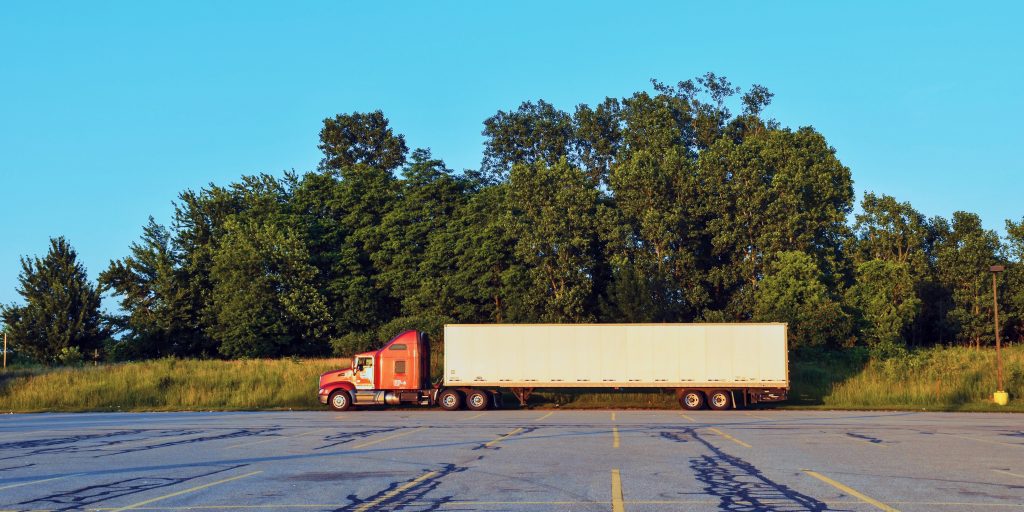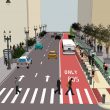On the road again: How cities can solve the truck-parking conundrum
American cities have a love-hate relationship with 18-wheelers. On one hand, trucks carry more than 70 percent of freight in the United States. It’s fair to say that everything from retail to restaurants would grind to a halt without them. On the other hand, they create significant problems for municipalities when it comes to traffic, safety, and pollution. But one of the biggest issues that local governments face is a seemingly simple one: where to park millions of trucks every day.
In rural areas or sparsely populated towns, this isn’t much of a problem where land is plentiful, and truckers can park their big rigs fairly close to where they drop their cargo off. This is a perfect solution, because truckers can empty their loads, park nearby overnight, refill their trailers in the morning, and be on their way. But in large cities where space is at a premium and parking is difficult to come by, this approach is impractical, if not impossible. And the stopgap measures that transportation companies and drivers use—such as parking on the side of a highway or on city streets—simply aren’t practical or sustainable.
It is impossible to overstate how serious the problem is. According to data from the Federal Highway Administration, 37 state departments of transportation reported problems related to parking trucks, especially in the Northeast and Mid-Atlantic states, the Pacific Northwest and California. In fact, the agency goes so far as to call truck parking shortages “a national safety concern” and calls for commercial truck drivers to have “access to safe, secure and accessible truck parking. With the projected growth of truck traffic, the demand for truck parking will continue to outpace the supply of public and private parking facilities and will only exacerbate the truck parking problems experienced in many regions.”
According to the Florida Department of Transportation (FDOT), there are only “300,000 truck parking spaces in the United States, with more than 272,000 of those at private truck stops.” That’s nowhere near enough to meet the demand of millions of trucks that are on the road every day. The current approach is for drivers to park their trucks at designated rest areas and truck stops, but in some urban areas these can be as far as 80 miles from the city center. That adds 160 miles of extra driving per load—this is not only expensive for operators, but it releases millions of tons of carbon into the atmosphere and creates safety hazards and traffic congestion as empty 18-wheelers take up space on the road. It’s a situation that isn’t good for anyone. According to the Mid America Association of State Transportation Officials (MAASTO), the estimated economic cost of 83 percent of drivers requiring 30 minutes to find parking is $7 billion annually. There has to be a better way.
The sharing solution
As it turns out, most cities don’t actually have a space issue: they have space allocation issues. No, there aren’t 50 undiscovered acres of land in downtown San Francisco or Midtown Manhattan, but the reality is that there is plenty of “dead space” that municipalities can access to provide parking for truckers that is safe and close. One great example is shopping malls. These facilities tend to have massive parking lots that are heavily used during business hours. But after the stores close, malls are essentially ghost towns until 8 o’clock the next morning. There are quite literally hundreds of thousands of acres of parking spaces in and near major American cities that are completely empty during the exact hours that truckers need to park their vehicles and rest.
The big problem is a “last-mile” issue of connecting transportation companies and owners of shopping centers, stadiums and other facilities that have excess parking space that drivers could use rather than forcing them to go back out on the highway or park in sketchy areas. After all, it takes a lot of work for logistics companies to start calling every mall in America to see if they can rent precious space so that their drivers will have a place to park overnight. This is a perfect opportunity for municipalities to take the lead and bridge this gap.
For starters, local officials know the major property owners in their areas and already have relationships that will allow them to open the conversation. It’s one thing if a trucker from across the country calls to request parking, but it’s quite another for someone on the city council to begin the dialogue. In addition, city and county governments can manage the logistics of creating designated overnight parking areas on private or public property. For example, many stadiums are owned by city and county governments, so there is no structural barrier to making a connection.
Truck parking is a significant problem in most American cities, but as it turns out, it is one that can be remedied. But to do so, there needs to be a partnership between logistics companies and property owners to create solutions that work for everyone. And city and county governments can play a vital role in making this happen.
Edward Moon is a growth marketer at Spacer Technologies a technology company that enables property owners to discover new revenue sources through innovative solutions that leverage unused spaces.




















